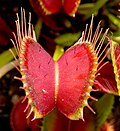Digestion
Digestion is the process of breaking down food to absorb it. Food is broken down into smaller pieces, which are soluble in water. Only then can the food be absorbed into the bloodstream.
Phases
Digestion happens in three phases.
Mechanical digestion is the physical breakdown of large pieces of food into smaller pieces, which are made by digestive enzymes. In chemical digestion, enzymes break down food into the small molecules the body can use. Finally, the nutrients are absorbed into the blood stream. Once in the blood stream, the nutrients are taken to the liver, which is a kind of chemical factory for the body.
Process
After we swallow food, it travels down a muscular tube to the stomach. There, it is mashed into soupy fluid called chyme. The mixture passes into the small intestine, where tiny bits of food pass into the bloodstream. The food that is still left goes into the large intestine. Finally, waste products leave the body.
Digestion usually takes about 18 hours. Food stays in the stomach for about three hours.[1] If uncoiled, the small intestine would be about six meters (20 feet) long.[2] Many digestive tracts are about as long as a bus.[2]
Food slowly enters the small intestine from the stomach. This is where nutrients are taken into the blood. It then enters the large intestine. Water is taken away from it. The food that is left is called feces. The feces are stored in the rectum until the waste can leave the body through the anus.
Organs
Digestion Media
Schematic drawing of bacterial conjugation. 1- Donor cell produces pilus. 2- Pilus attaches to recipient cell, bringing the two cells together. 3- The mobile plasmid is nicked and a single strand of DNA is transferred to the recipient cell. 4- Both cells recircularize their plasmids, synthesize second strands, and reproduce pili; both cells are now viable donors.
Trophozoites of Entamoeba histolytica with ingested erythrocytes
Related pages
Other websites
- Human Physiology - Digestion Archived 2011-10-31 at the Wayback Machine
- NIH guide to digestive system Archived 2006-08-10 at the Wayback Machine
References
- ↑ Morris, Neil; Ting Morris (1998). Jim Miles, Lynne French (ed.). Children's First Encyclopedia. Branka Surla, Rosie Alexander. Miles Kelly Publishing, Bardfield, Essex. ISBN 1-84084-332-2. Accessed 13 July 2010.
- ↑ 2.0 2.1 My First Book on the Human Body. Bath: Robert Frederick Ltd. 2004. ISBN 0-7554-3506-0. Accessed 13 July 2010.





